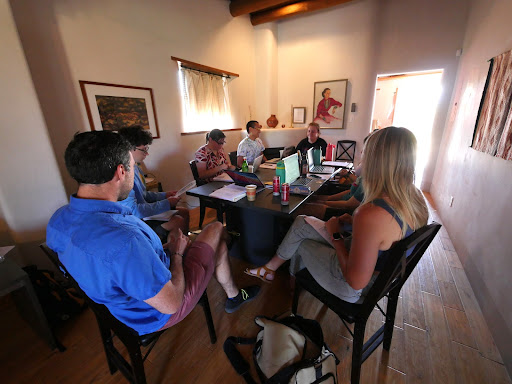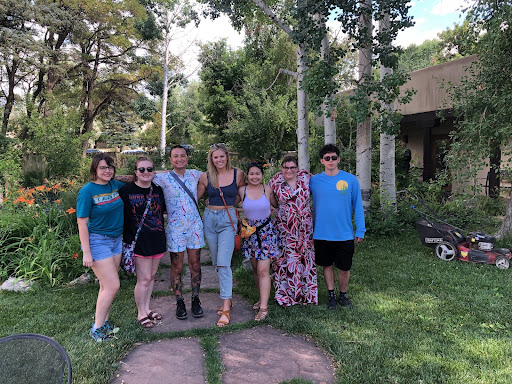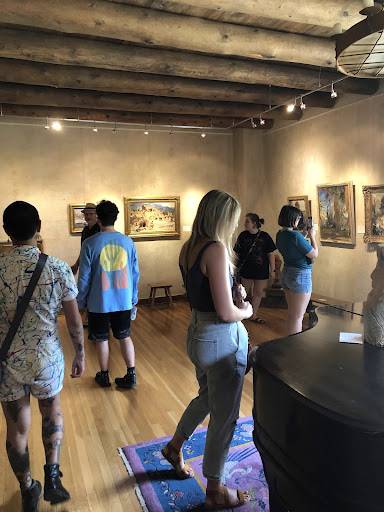Meet Professor Michael Armory
Assistant Professor of English, Michael Armory, Ph.D. lead a course with seven students titled Narratives of Identity: Individual, Community, and Place at the Doel Reed Center in Summer 2021.
Meet Michael Armory, Ph.D., Assistant Professor of English at Oklahoma State University, as he leads a discussion with his class of seven students at the Doel
Reed Center in Taos. Dr. Armory taught Narratives of identity: Individual, Community, and Place and designed the curriculum to incorporate many of the unique cultural characteristics
found in the Taos community. Having the opportunity to observe and interview members
of different cultures created meaningful learning environments that led to deep and
insightful class discussions. Read more about Dr. Armory’s experience as an instructor
at the Doel Reed Center in Taos.
University, as he leads a discussion with his class of seven students at the Doel
Reed Center in Taos. Dr. Armory taught Narratives of identity: Individual, Community, and Place and designed the curriculum to incorporate many of the unique cultural characteristics
found in the Taos community. Having the opportunity to observe and interview members
of different cultures created meaningful learning environments that led to deep and
insightful class discussions. Read more about Dr. Armory’s experience as an instructor
at the Doel Reed Center in Taos.
 “This past Summer 2021, I had the absolute pleasure of teaching a two-week academic
credit course at the Doel Reed Center in Taos to both undergraduate and graduate students
from a variety of disciplines and programs. This course was entitled Narratives of identity: Individual, community, and place and focused on the analysis of narratives and storytelling and the ways in which
they construct individual and community identity as historically and culturally grounded
experience. As a multicultural community, Taos provided an ideal location for students
to experience and explore multicultural and multilingual communities and the stories
that shape, conceptualize, and contextualize them. Throughout the two weeks, we were
able to relate narratives and storytelling practices to community and place through
multicultural visits and field trips in both Taos and Santa Fe. We were able to explore
the historic Taos plaza, toured Earthship Biotecture, had a cooking class with Norma
Naranjo in the Ohkay Owingeh Pueblo, visited the New Mexico History Museum’s “Telling
New Mexico: Stories from Then and Now” exhibit, among various other cultural activities.
We considered how insights gleaned from our in-class readings and discussions, as
well as from the field trips, might enhance a teachers’ understanding of their students’
lived experiences and influence their practice of teaching.
“This past Summer 2021, I had the absolute pleasure of teaching a two-week academic
credit course at the Doel Reed Center in Taos to both undergraduate and graduate students
from a variety of disciplines and programs. This course was entitled Narratives of identity: Individual, community, and place and focused on the analysis of narratives and storytelling and the ways in which
they construct individual and community identity as historically and culturally grounded
experience. As a multicultural community, Taos provided an ideal location for students
to experience and explore multicultural and multilingual communities and the stories
that shape, conceptualize, and contextualize them. Throughout the two weeks, we were
able to relate narratives and storytelling practices to community and place through
multicultural visits and field trips in both Taos and Santa Fe. We were able to explore
the historic Taos plaza, toured Earthship Biotecture, had a cooking class with Norma
Naranjo in the Ohkay Owingeh Pueblo, visited the New Mexico History Museum’s “Telling
New Mexico: Stories from Then and Now” exhibit, among various other cultural activities.
We considered how insights gleaned from our in-class readings and discussions, as
well as from the field trips, might enhance a teachers’ understanding of their students’
lived experiences and influence their practice of teaching.
The students formed and fostered close connections with each, and we were able to learn a great deal from each other through meaningful and engaging discussions. The final projects were adapted to each students’ area of study and interest, and they submitted incredibly wonderful and creative final projects. These projects ranged from poetry chapbooks which explored the multifaceted and complicated nature of identity construction, to multimodal personal narratives of identity formation with a critical commentary inspired by time spent in Taos and its surrounding areas, to course development projects which focused on helping teachers promote and incorporate their students’ diverse voices in the classroom.
This course would not have been possible with the support of very generous donors. Without the scholarships provided, the students commented that they otherwise would not have been able to attend. I am forever grateful to the donors, for this experience, and to the students who attended the class .”
